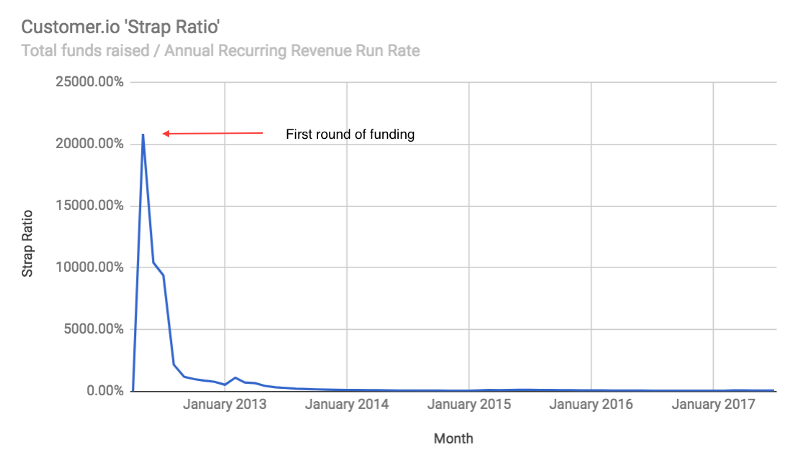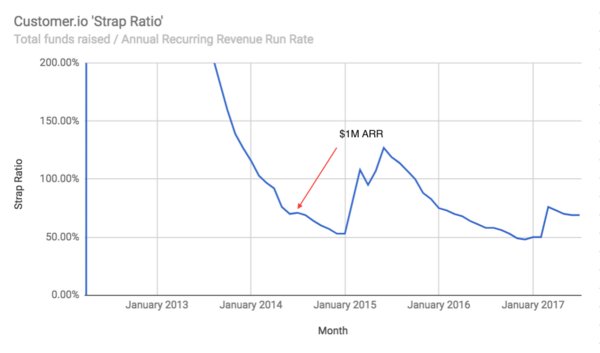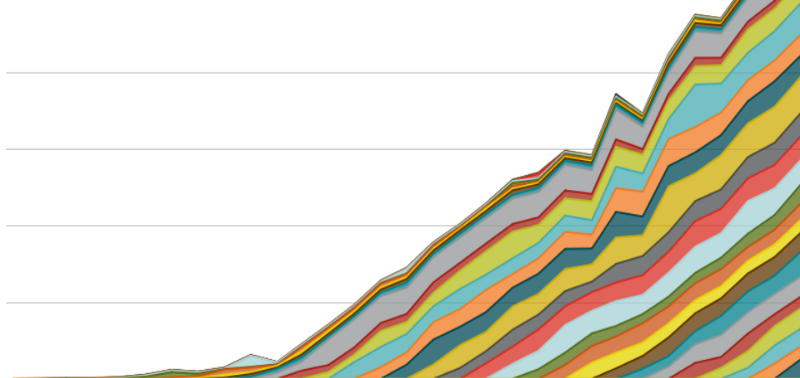Strap Ratio
To get Customer.io off the ground in May 2012, we raised $125k in small checks from friends and family plus two angel investors. At the time of that investment, our total capital raised was equivalent to two hundred and eight times (20,833% of) our current annual revenue run rate (ARR).

Our strap ratio peaked on our first raise at 20,833%We were making about $50 per month or $600 a year.
Our business was risky. We had almost no revenue. Unless we made a miracle happen or raised money, we’d likely have to close up shop. Without much to lose, we were fine to spin the roulette wheel and bet it all on red.
Over time we’ve received additional investments, but we haven’t continued down the path of betting it all on red and doing things like raising 20,833% of revenue each time we’ve fundraised.

We’ve raised multiple rounds of financing, each time peaking at a much lower strap ratio. In 2013, after a sharply declining strap ratio (and almost running out of funds), we raised more money bringing the total to 1,103% of ARR. Then in 2015 we did it again. This time it was 127% of ARR. Most recently in 2017 we saw an opportunity to invest in the business ahead of revenue again and raised a fraction of our ARR bringing our total funds raised to 76% of ARR.
VC-backed companies track metrics like valuation, ARR, and rates of growth, but they often overlook the capital it took to achieve those outcomes. Capital efficiency isn’t considered. The company places bigger and bigger bets on hard-to-achieve outcomes. The tradeoff is often ownership and control for the founders, and if proven wrong, the outcome is layoffs, forced exits, and burned and angry employees and customers.
Fundstrapping is about using capital as a tool to best serve all stakeholders — customers, employees and owners. The strap ratio is what we call the ratio of total capital raised to ARR, and it’s a key metric we use to understand how well we’re using capital to build our business.
Over time, your total capital raised should fall well below your ARR, with subsequent fundraising supporting calculated bets to grow. Fundstrapping is a way to get your company all of the benefits of outside funding — while minimizing your exposure to the downsides.
Raising money is risky
Raising any money for your business creates risks.
Every time you take on capital, you raise the bar for where you need to go. The more capital you raise, the higher the bar gets, and the more risks you have to take to meet the bar. Early on, when your strap ratio is 11,000% (or “NaN” — Not a Number if you just tried to divide your total money raised by $0 in revenue), you’re gambling. You’re throwing everything you have into a product idea and seeing what happens.
We’ve all seen companies continue to raise big rounds to double down again and again on their initial bet. They often don’t have the details figured out or they’re making big assumptions. By raising a big round,
- They’ve just traded away the time to figure things out for more money.
- They’ve risked the whole company (and their employees, and their customers) to make a speculative bet that they can make magic happen. (It’s always good to keep in mind that statistically speaking the average VC funded company is more likely to fail than succeed.) The sad part is that this means companies often fail totally unnecessarily. Their underlying ideas are sound, but they bet too big with funding rounds that are out of proportion with their traction as measured by ARR. They overexpose themselves to risk. Then, their employees and their customers end up bearing the brunt of it when those businesses close up shop.
As your product matures and your ARR grows, betting everything on red becomes irresponsible. Customers rely on your company to continue existing. This is doubly true for Customer.io, which has become critical email infrastructure for thousands of companies.
Not raising is also risky
As we’ve added more customers and grown the business, we’ve benefited from being able to invest more capital than our monthly revenue supported.
We learned the downside of not raising money the hard way. For all of 2014, we underspent on the company and the business suffered as a result. We increased ARR by 20x in 2013, but we only grew it by 2.5x in 2014 when we had the potential to grow considerably faster. In early 2014, our infrastructure was groaning under the pressure of rapid growth and we allowed our cash constraints to keep us from hiring quickly enough to serve our customers best.
In early 2015, we raised more money, grew the team 3x and made sure we focused on customers 100%. We’ve continued to raise money, but each time we’ve needed to raise a smaller percentage of revenue in each subsequent raise in order to achieve our goals.
SaaS businesses are like snowballs rolling down a hill. They’re hard to get started, and that’s where the first round of funding really helps. It can buy you a year and change to build the product and get your first few customers.
Once SaaS companies get rolling, they build more and more momentum over time. They need less funding in proportion to the snowball’s size to propel it forward. Once the snowball is big enough, it becomes nearly unstoppable.
Fund your company if it helps serve customers best
With fundstrapping, capital is a tool to serve customers and grow your business. It’s not a scarce resource that you need to optimize for as with bootstrapping, nor is it a means to the end of attracting even more capital as with the traditional VC model.
- If your total funds raised to ARR ratio is low and you’re cash constrained, consider raising more money to grow your ARR faster.
- If your total funds raised to ARR ratio is high and you’re not cash constrained, get capital creative by finding efficient ways to spend your money to grow your ARR and reduce your ratio over time. What you’re looking for is a healthy balance between capital raised and the size of your business. By reducing cash as a constraint, you make sure your focus is always on the customer. By minimizing dependence on outside capital, you ensure that you always have a path to profitability, and that means that you control your own destiny to build the company that you want to build.
At Customer.io, we’ve developed these strap ratio benchmarks to help us decide when and how much to raise.

- From $0 — $1M in ARR, you will probably have an astronomical strap ratio if you raise money but want your strap ratio quickly trending towards 100% or less.
- After $1M in ARR, fundstrapping responsibly means maintaining a strap ratio of 50% to 150%, which means you’re using external capital, but not excessively. 200% is the upper bound if you need to make a very aggressive move.
